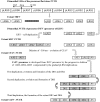Molecular archaeology of Flaviviridae untranslated regions: duplicated RNA structures in the replication enhancer of flaviviruses and pestiviruses emerged via convergent evolution
- PMID: 24647143
- PMCID: PMC3960163
- DOI: 10.1371/journal.pone.0092056
Molecular archaeology of Flaviviridae untranslated regions: duplicated RNA structures in the replication enhancer of flaviviruses and pestiviruses emerged via convergent evolution
Abstract
RNA secondary structures in the 3'untranslated regions (3'UTR) of the viruses of the family Flaviviridae, previously identified as essential (promoters) or beneficial (enhancers) for replication, have been analysed. Duplicated enhancer elements are revealed as a global feature in the evolution of the 3'UTR of distantly related viruses within the genera Flavivirus and Pestivirus. For the flaviviruses, duplicated structures occur in the 3'UTR of all four distantly related ecological virus subgroups (tick-borne, mosquito-borne, no known vector and insect-specific flaviviruses (ISFV). RNA structural differences distinguish tick-borne flaviviruses with discrete pathogenetic characteristics. For Aedes- and Culex-associated ISFV, secondary RNA structures with different conformations display numerous short ssRNA direct repeats, exposed as loops and bulges. Long quadruplicate regions comprise almost the entire 3'UTR of Culex-associated ISFV. Extended duplicated sequence and associated RNA structures were also discovered in the 3'UTR of pestiviruses. In both the Flavivirus and Pestivirus genera, duplicated RNA structures were localized to the enhancer regions of the 3'UTR suggesting an adaptive role predominantly in wild-type viruses. We propose sequence reiteration might act as a scaffold for dimerization of proteins involved in assembly of viral replicase complexes. Numerous nucleotide repeats exposed as loops/bulges might also interfere with host immune responses acting as a molecular sponge to sequester key host proteins or microRNAs.
Conflict of interest statement
Figures



Similar articles
-
Origin and evolution of 3'UTR of flaviviruses: long direct repeats as a basis for the formation of secondary structures and their significance for virus transmission.Adv Virus Res. 2007;69:203-48. doi: 10.1016/S0065-3527(06)69005-2. Adv Virus Res. 2007. PMID: 17222695 Review.
-
Functional RNA Structures in the 3'UTR of Tick-Borne, Insect-Specific and No-Known-Vector Flaviviruses.Viruses. 2019 Mar 24;11(3):298. doi: 10.3390/v11030298. Viruses. 2019. PMID: 30909641 Free PMC article.
-
Noncoding Subgenomic Flavivirus RNA Is Processed by the Mosquito RNA Interference Machinery and Determines West Nile Virus Transmission by Culex pipiens Mosquitoes.J Virol. 2016 Oct 28;90(22):10145-10159. doi: 10.1128/JVI.00930-16. Print 2016 Nov 15. J Virol. 2016. PMID: 27581979 Free PMC article.
-
Using SHAPE-MaP To Model RNA Secondary Structure and Identify 3'UTR Variation in Chikungunya Virus.J Virol. 2020 Nov 23;94(24):e00701-20. doi: 10.1128/JVI.00701-20. Print 2020 Nov 23. J Virol. 2020. PMID: 32999019 Free PMC article.
-
Functional non-coding RNAs derived from the flavivirus 3' untranslated region.Virus Res. 2015 Aug 3;206:53-61. doi: 10.1016/j.virusres.2015.01.026. Epub 2015 Feb 7. Virus Res. 2015. PMID: 25660582 Review.
Cited by
-
Characterization of a novel insect-specific flavivirus from Brazil: potential for inhibition of infection of arthropod cells with medically important flaviviruses.J Gen Virol. 2014 Dec;95(Pt 12):2796-2808. doi: 10.1099/vir.0.068031-0. Epub 2014 Aug 21. J Gen Virol. 2014. PMID: 25146007 Free PMC article.
-
Functional Information Stored in the Conserved Structural RNA Domains of Flavivirus Genomes.Front Microbiol. 2017 Apr 3;8:546. doi: 10.3389/fmicb.2017.00546. eCollection 2017. Front Microbiol. 2017. PMID: 28421048 Free PMC article. Review.
-
A multiplex ELISA-based protein array for screening diagnostic antigens and diagnosis of Flaviviridae infection.Eur J Clin Microbiol Infect Dis. 2015 Jul;34(7):1327-36. doi: 10.1007/s10096-015-2353-6. Epub 2015 Mar 22. Eur J Clin Microbiol Infect Dis. 2015. PMID: 25796511
-
RNA Structure Duplication in the Dengue Virus 3' UTR: Redundancy or Host Specificity?mBio. 2019 Jan 8;10(1):e02506-18. doi: 10.1128/mBio.02506-18. mBio. 2019. PMID: 30622191 Free PMC article.
-
The 5' and 3' Untranslated Regions of the Flaviviral Genome.Viruses. 2017 Jun 6;9(6):137. doi: 10.3390/v9060137. Viruses. 2017. PMID: 28587300 Free PMC article. Review.
References
-
- Lindenbach BD, Rice CM (2001) Flaviviridae: The Viruses and Their Replication. In: Knippe DM, Howley PM, editors. Fields Virology. London-New York-Tokyo: Lippincott Williams & Wilkins. pp. 991–1042.
-
- Heinz FX, Collett MS, Purcell RH, Gould EA, Howard CR, et al.. (2000) Family Flaviviridae In: M.H.V R, Fauquet CM, Bishop DHL, Carstens E, Estes MK et al.., editors. Virus Taxonomy 7th International committee for the Taxonomy of Viruses. San Diego: Academic Press. pp. 859–878.
-
- Grard G, Moureau G, Charrel RN, Lemasson JJ, Gonzalez JP, et al. (2007) Genetic characterization of tick-borne flaviviruses: new insights into evolution, pathogenetic determinants and taxonomy. Virology 361: 80–92. - PubMed
-
- Gould EA, Solomon T (2008) Pathogenic flaviviruses. Lancet 371: 500–509. - PubMed
-
- Gritsun TS, Nuttall PA, Gould EA (2003) Tick-borne flaviviruses. Adv Virus Res 61: 317–371. - PubMed
Publication types
MeSH terms
Substances
Grants and funding
LinkOut - more resources
Full Text Sources
Other Literature Sources

